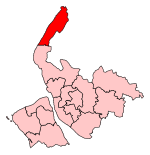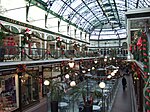Southport Arts Centre
Buildings and structures in SouthportGrade II listed buildings in MerseysideTheatres in Merseyside

Southport Arts Centre, formerly known as Cambridge Hall, is on the east side of Lord Street, Southport, Sefton, Merseyside, England, and stands between Southport Town Hall and the Atkinson Art Gallery and Library. It was built in 1873–74 and originally contained an assembly hall. The centre contains mixed architectural styles and has a tall clock tower at the right end. During the 20th century the assembly hall was converted into a theatre, and it forms part of the arts complex known as The Atkinson. The arts centre is recorded in the National Heritage List for England as a designated Grade II listed building.
Excerpt from the Wikipedia article Southport Arts Centre (License: CC BY-SA 3.0, Authors, Images).Southport Arts Centre
Lord Street,
Geographical coordinates (GPS) Address Website Nearby Places Show on map
Geographical coordinates (GPS)
| Latitude | Longitude |
|---|---|
| N 53.6472 ° | E -3.006 ° |
Address
The Atkinson
Lord Street
PR8 1DB
England, United Kingdom
Open on Google Maps










